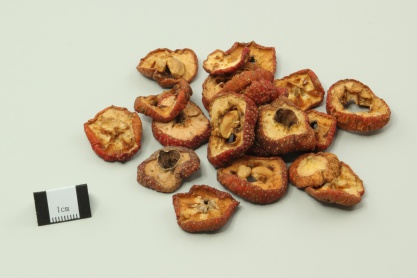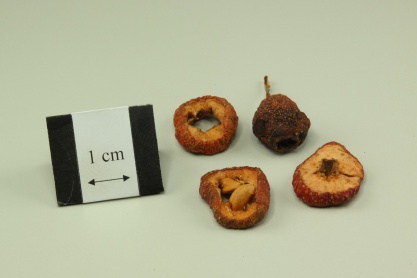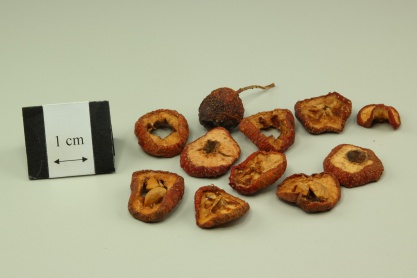- ENG
- Hawthorn Fruit
- LATIN
- Crataegi Fructus
| Medicinal Group | Digestant medicinal |
|---|---|
| Source | Dried ripe fruit of Crataegus pinnatifida Bge. var. major N. E. Br. or Crataegus pinnatifida Bge. (Fam. Rosaceae) |
| Nature and Flavors | sweet, sour; slightly warm |
| Meridian Affinity | Liver, Spleen, Stomach |
| Actions | To promote digestion and invigorate the stomach, improve the normal flow of qi and dissipate blood stasis |
Family
Part used
Indications
Stagnation of indigested meat with epigastric distension, diarrhea and abdominal pain; amenorrhea due to blood stasis, epigastric pain or abdominal colic after childbirth; hernial pain; hyperlipemia
Research Findings
- The Chinese hawthorn fruit has demonstrated efficacy in lowering blood cholesterol and the risk of cardiovascular diseases, anti-inflammatory and anti-tumour activities.[1]
- It may be possible to use Hawthorn extracts in personnel exposed to radiation in order to protect lymphocytes from radiation effects.[2]
- Hawthorn Fruit was the most often used herb in the treatment of nonalcoholic fatty liver disease. [4]
- Detoxifying and blood circulation activating Chinese herb extraction of polygonum cuspidatum and hawthorn has good effect of anti-atherosclerosis and promoting plaque stability.[5]
- Chinese herbs for resolving phlegm and dampness, smoothing liver and gallbladder, promoting blood circulation and removing blood stasis (composed of Fructus Crataegi) could effectively improve liver function and fibrinolytic status. [6]
Cautions
Report on adverse effect
At therapeutic dosages, hawthorn may cause a mild rash, headache, sweating, dizziness, palpitations, sleepiness, agitation, and gastrointestinal symptoms. Hawthorn may interact with vasodilating medications and may potentiate or inhibit the actions of drugs used for heart failure, hypertension, angina, and arrhythmias.[3]
Cause formation of gastric bezoars [7, 8, 9]
Intestinal infarction [10]
Increased blood pressure and heart rate [11]
Reference
Reference
- Jurikova T, Sochor J, Rop O, Mlcek J, Balla S, Szekeres L, Adam V, Kizek R. (2012). Polyphenolic profile and biological activity of Chinese hawthorn (Crataegus pinnatifida BUNGE) fruits. Molecules. , 17(12):14490-509. doi: 10.3390/molecules171214490.
- Hosseinimehr SJ, Mahmoudzadeh A, Azadbakht M, Akhlaghpoor S. (2009). Radioprotective effects of Hawthorn against genotoxicity induced by gamma irradiation in human blood lymphocytes. Radiat Environ Biophys. , 48(1):95-8. doi: 10.1007/s00411-008-0190-z. Epub 2008 Sep 4.
- Rigelsky JM, Sweet BV. (2002). Hawthorn: pharmacology and therapeutic uses. Am J Health Syst Pharm. , 59(5):417-22.
- Shi KQ, Fan YC, Liu WY, Li LF, Chen YP, Zheng MH. ( 2012). Traditional Chinese medicines benefit to nonalcoholic fatty liver disease: a systematic review and meta-analysis. Mol Biol Rep. , 39(10):9715-22. doi: 10.1007/s11033-012-1836-0. Epub 2012 Jun 21.
- Liu LT, Zheng GJ, Zhang WG, Guo G, Wu M. (2014). Clinical study on treatment of carotid atherosclerosis with extraction of polygoni cuspidati rhizoma et radix and crataegi fructus: a randomized controlled trial. Zhongguo Zhong Yao Za Zhi. , 39(6):1115-9.
- Chen L, Jiang YK, Cai YB. (2006). Effects of resolving phlegm method on fibrinolytic status in non-alcoholic steatohepatitis patients of phlegm and blood-stasis syndrome. Zhongguo Zhong Xi Yi Jie He Za Zhi. , 26(12):1090-3.
- 熊愛玲 (2002)。<胃山楂結石治驗1例>。山西中醫,1。
- 蘇兆連 (2001)。<胃山楂結石1例治療報告>。 安徽中醫臨床雜誌,3。
- 孔祥蘭、董美芝、張廣凱、油光之 (1993)。<胃山楂結石25例X線表現及形成機制>。菏澤醫專學報,1。
- 康俊升 (1999)。<食用生山楂引起腸石性小腸梗阻附13 例報告>。中國普通外科雜誌,4( 8) : 283-283。
- Cheng, K. F., Leung, K. S., & Leung, P. C. (2003). Interactions between modern and chinese medicinal drugs: A general review. The American Journal of Chinese Medicine, 31(2), 163-169.













